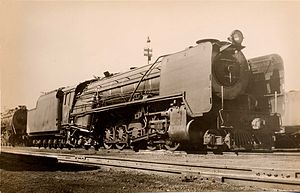SAR class 21
| SAR class 21 | |
|---|---|
|
SAR class 21
|
|
| Numbering: | 2551 |
| Number: | 1 |
| Manufacturer: | North British |
| Year of construction (s): | 1937 |
| Retirement: | 1952 |
| Type : | 1'E2 'h2 |
| Gauge : | 1067 mm ( cape track ) |
| Length over coupling: | 23,425 mm |
| Service mass: | 108.3 t |
| Service mass with tender: | 175.1 t |
| Wheel set mass : | 15.2 t |
| Driving wheel diameter: | 1,372 mm |
| Cylinder diameter: | 610 mm |
| Piston stroke: | 660 mm |
| Boiler overpressure: | 144.7 N / cm² |
| Grate area: | 5.85 m² |
| Train brake: | Suction air brake |
The locomotive Class 21 of the South African Railways (SAR) was a steam locomotive with the wheel arrangement 1'E2 '( Texas ). The one-off with track number 2551 was delivered by North British in 1937 .
The locomotive was created with the intention of building a locomotive that was as powerful as possible, but not articulated, with an axle load of 15 t. In order to be able to drive through tighter curves, the wheels of the drive axle and another coupling axle were designed without flanges. The boiler was the standard 3B boiler , which was also used in classes 15E and F as well as 23. Originally - like many locomotives built for the SAR at that time - a Caprotti valve control was planned, but the locomotive was then built with Walschaerts control.
The six-axle tender - the first of the SAR - was also a test construction: It had an axle sequence of 1'4 1 ', i.e. four axles fixed in the frame and two end axles designed as a Bissel frame . The experiment was not repeated; all other six-axle tenders of SAR received three-axle bogies.
Five-coupled locomotives could not establish themselves in South Africa either. Only one type was built in series, the “Reid ten-wheeler” of Natal Government Railways , which was introduced in 1899 . The total of only four five-way coupled tender locomotives were divided into three experimental designs: Class 18 (1'E1 ') with three-cylinder engine built in 1927 , Class 20 (also 1'E1') built in 1934 and finally Class 21.
The No. 2551 was mainly used in the Pretoria region and was scrapped in 1952 after 15 years of operation.
Class 22
The SAR had another 1'E2 'locomotive in the planning stage, which, in contrast to class 21, was designed for 22 t axle load. A drive wheel diameter of 5 feet (1524 mm), a grate area of 7.43 m² and a total weight (without tender) of about 142 t were planned. The locomotive would have been bigger and heavier than the class 25 built after the war (wheel arrangement 2'D2 'with the same drive wheel diameter).
Although the design was given the class designation 22, it was not built because the high axle load would have limited the use of the locomotive to a few main routes. 22 is the only gap in the class designations 1 to 26 for the SAR steam locomotives with a tender.
See also
literature
- Leith Paxton, David Bourne: Locomotives of the South African Railways. A Concise Guide. C. Strui (Pty) Ltd., Cape Town 1985, ISBN 0-86977-211-2 .
- John N. Middleton: Railways of Southern Africa. Locomotive guide. 5th edition. Beyer-Garratt Publications, Rickmansworth 1994, ISBN 0-620-18548-1 .
Individual evidence
- Technical data and imaging (English)
